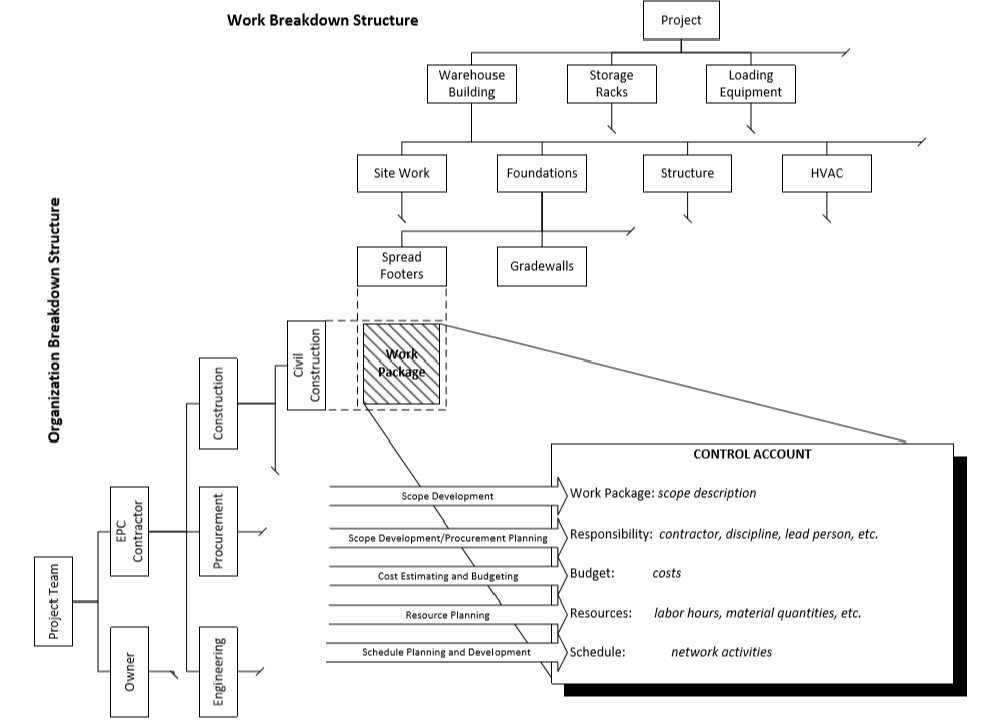In a nutshell, OBS is the team structure of the project depicting the extended team covering Owner, Consultants, Contractors, Sub-contractors, Suppliers including all trades.
A project organization breakdown structure (OBS) is a hierarchical representation of the organizational structure of a project, showing how various resources, roles, and responsibilities are distributed. It provides a clear picture of who is responsible for what within the project. Let’s break down the concept using examples from both Engineering, Procurement, and Construction (EPC) projects and Information Technology (IT) projects:
- EPC Project: In an EPC project, such as building a power plant, the OBS would typically include the following levels:
- Project Manager: Responsible for overall project management and coordination.
- Engineering Team: Responsible for designing the power plant.
- Mechanical Engineer: Responsible for mechanical systems design.
- Electrical Engineer: Responsible for electrical systems design.
- Civil Engineer: Responsible for civil works design.
- Procurement Team: Responsible for sourcing materials and equipment.
- Procurement Manager: Responsible for overall procurement activities.
- Procurement Officer: Responsible for purchasing materials.
- Construction Team: Responsible for building the power plant.
- Construction Manager: Oversees construction activities.
- Site Engineer: Responsible for on-site supervision.
- Construction Workers: Execute construction tasks.
- Engineering Team: Responsible for designing the power plant.
- Project Manager: Responsible for overall project management and coordination.
- IT Project: In an IT project, such as developing a new software application, the OBS would look somewhat different:
- Project Manager: Oversees the entire project.
- Development Team: Responsible for creating the software.
- Software Architect: Designs the software architecture.
- Programmers: Write the code.
- Testers: Verify the functionality and quality of the software.
- IT Operations Team: Responsible for deploying and maintaining the software.
- System Administrators: Manage servers and IT infrastructure.
- Network Engineers: Ensure network connectivity and security.
- Support Team: Provides ongoing support to users.
- Help Desk Staff: Assist users with issues and inquiries.
- Technical Support Specialists: Handle more complex technical issues.
- Development Team: Responsible for creating the software.
- Project Manager: Oversees the entire project.
In both examples, the OBS clarifies the roles and responsibilities of different teams and individuals within the project. It helps ensure that everyone knows their role and who to report to, which ultimately contributes to smoother project execution and successful completion.
Linking WBS and OBS
Linking the Organization Breakdown Structure (OBS) with the Work Breakdown Structure (WBS) is crucial for effective project management. The OBS defines the organizational structure, roles, and responsibilities, while the WBS breaks down the project scope into manageable tasks.

Let’s explore how they are linked using examples from both EPC and IT projects:
- EPC Project: Let’s consider the construction of a new refinery as an example.
- Organization Breakdown Structure (OBS):
- Project Manager
- Engineering TeamProcurement TeamConstruction Team
- Phase 1: Engineering
- Task 1.1: Conceptual DesignTask 1.2: Detailed Engineering
- Task 2.1: Material IdentificationTask 2.2: Vendor Selection
- Task 3.1: Site PreparationTask 3.2: Foundation Construction
- The Project Manager oversees all phases of the project, ensuring alignment with project objectives.The Engineering Team, led by the Engineering Manager, is responsible for completing tasks within the “Engineering” phase of the WBS.The Procurement Team, led by the Procurement Manager, executes tasks related to procurement activities defined in the “Procurement” phase of the WBS.The Construction Team, led by the Construction Manager, carries out tasks related to construction activities specified in the “Construction” phase of the WBS.
- Project Manager
- Organization Breakdown Structure (OBS):
- IT Project: Let’s consider the development of a mobile application as an example.
- Organization Breakdown Structure (OBS):
- Project Manager
- Development Team
- IT Operations Team
- Support Team
- Project Manager
- Work Breakdown Structure (WBS):
- Phase 1: Planning and Analysis
- Task 1.1: Requirements Gathering
- Task 1.2: Feasibility Study
- Phase 2: Development
- Task 2.1: UI/UX Design
- Task 2.2: Backend Development
- Phase 3: Testing and Deployment
- Task 3.1: Unit Testing
- Task 3.2: User Acceptance Testing
- Phase 1: Planning and Analysis
- Linking OBS with WBS:
- The Project Manager oversees all phases of the project, ensuring alignment with project goals and stakeholder expectations.
- The Development Team, led by the Software Architect, is responsible for executing tasks within the “Development” phase of the WBS.
- The IT Operations Team, led by the System Administrator, handles tasks related to deployment and maintenance specified in the “Testing and Deployment” phase of the WBS.
- The Support Team, led by the Help Desk Manager, addresses tasks associated with user support outlined in the “Testing and Deployment” phase of the WBS.
- Organization Breakdown Structure (OBS):
1 / 2

